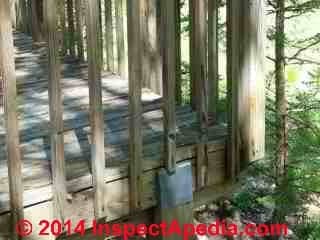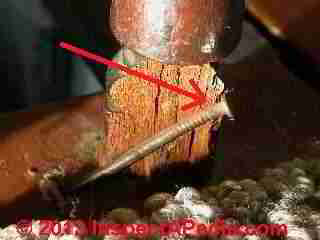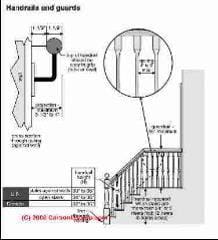 Stair Baluster Codes & Specifications
Stair Baluster Codes & Specifications
Building Code, Construction, & Safety Inspection of Stairway & Guardrail Balusters
- POST a QUESTION or COMMENT about stair baluster safety, inspection, building codes & specifications
Stair baluster safety & code specifications:
This article describes procedures for performing safety inspections of the balusters used on indoor or outdoor stairs, railings, landings.
As our photo shows, Chloe Mei, a toddler (in this case very carefully held and supervised) could easily fall through widely separated open landing balusters or open balusters on a stairway.
InspectAPedia tolerates no conflicts of interest. We have no relationship with advertisers, products, or services discussed at this website.
- Daniel Friedman, Publisher/Editor/Author - See WHO ARE WE?
Balusters and Safe Spacing for Stair Railings & Balcony or Landing Rails

Having investigated cases of severe injury related to falls and railing collapses we developed this field data collection checklist. We also include references to key documents on building codes and stair and railing safety.
Injuries due to stair or guardrail baluster failures do occur, it's not just theory.
In 2006 a Tampa Bay Florida child, Julia Grimes, was critically injured after a glue-and-staple-constructed guardrail at the top of a residential stair gave way.
This accident could have been prevented if the home's owners had understood the implication of loose, wobbly balusters and guardrailing, but news reports of the guardrail failure also suggest that the railing in a home built in 1994 and constructed using glue and staples, was unable to withstand anticipated loads (200 pounds) or even smaller forces such as that imposed by a child leaning on the railing. - Tampa Bay Times, 18 January 2006 cited atReferences or Citations
Even if the guardrailing has adequate strength it may be unsafe if it is too low or if the spacing between its balusters is too great. Horizontal guardrail enclosures are also a child hazard.
We often see guards and railings enclosed using horizontal members or mesh or link fencing materials. Because a toddler can easily climb these materials, they are not safe for guard or railing enclosures and should not be used.
We also often see decks and porches more than 30" above ground level with no guardrail whatsoever, perhaps relying on the placement of plants or furniture to discourage people from stepping too close to the edge.
Where building code enforcement was absent or lax we found a deck eight feet above ground with no railings at all. A local inspector opined that because the deck was not attached to the house (it abutted the house) it was exempt from building code enforcement.
Our opinion was that code exemption did not do much to reduce the falling hazard and that guards and railings should be provided regardless.
Look closely at stair and guard rail balusters for loose, split, broken, or damaged balusters. Someone tried an over-sized common nail to "repair" this loose baluster at its connection to the stair tread.
The result is a dangerous child hazard as this baluster could easily be pushed out of place.
Baluster Spacing Rules for Guards & Railings
Stairway handrail & stair balusters & guard details are in this sketch.
Balusters (vertical posts comprising the barrier in guards and railings)
- Baluster opening between vertical members
(maximum sphere passage <= 4 3/8" or in U.S. and some other jurisdictions <= 4") [
Thanks to Steve Stanczyk for pointing out that 4 inches is the maximum recommended baluster space opening width] - Baluster opening in triangular area below stair guard bottom rail and stair tread
(maximum sphere passage <= 6")
Hand-railing heights are given:
- U.S. handrails for stairs with one side against a wall: 30-38"
- U.S. handrails at open stairs: 34-38" above the stairs
- Canadian stair handrails: 32-36" above the stairs
- Wall clearance:
Handrails along a wall must have at least 1.5" of clearance between the inside surface of the rail and the wall surface. - Railings should not project
into the required width of the stairway by more than 4.5" at or below the handrail height above the stairs. - Floor clearance:
OPINION: we recommend either 4" between bottom surface of the guardrail or stair rail bottom and the top of the floor surface, or use 2" or less to avoid a foot trap. See the foot trap anecdote we report
at GUARDRAIL CODES & STANDARDS
Sketch courtesy of Carson Dunlop Associates, a Toronto home inspection, education & report writing tool company [ carsondunlop.com ].
How to Fix Too-Wide Stair Baluster Spacing
Reader Question: Methods for reducing the space between stair balusters that are too far apart
We have an apartment complex in Oregon, and the insurance company is requiring that we tighten up the metal posts on the railings.
The railings on the premises currently have vertical balusters that are more than 4 inches apart. Baluster spacing of 4 inches increase the protection for small children sliding through.
It is recommended to replaced the railing with vertical balusters that are no more than 4 inches apart to reduce the risk of small children falling. Is there an easy fix for this? - Tami 7/23/12
Reply: Suggestions for tightening up baluster spacing at a stair railing:
Tami:
We made this same repair recently on a circular stair that had vertical balusters that were too far apart by having our welder add additional balusters in between the existing ones so that the opening was less than 4" between baluster pairs.This was less costly than tearing out the whole rail and building a new one to exactly 4" on spec. Our new balusters varied a bit but were about 3.5" apart side to side or on center.
Watch out though: if you make the vertical balusters too close together, but far enough apart for a toddler to stick a foot through the space - say 2 1/2" they can become a foot trap. No child will fall through but s/he an get a foot stuck in the space by inserting it between the balusters, then turning it to one side.The ensuing panic requires an adult to sort out and remove the foot - as happened with my Godson Joshua Waterman years ago. His mom called me in hysterics that his foot was stuck in the balusters at their home and he couldn't get it out.
I drove like a madman across town but just as I arrived in the driveway Josh turned his foot the proper direction and extracted himself from the trap without any adult assistance.
Full Text of Adopted Building Codes 2006, 2012
- ALASKA, ARKANSAS, & Other U.S. STATES 1 & 2 FAMILY BUILDING CODE 2006 [PDF] Alaska, Arkansas, Colorado, District of Columbia, Georgia, Kentucky, Minnesota, Montana, Nevada, New HYork, South Carolina, Wyoming, et alia as they adopted their version of the International Residential Code® For One- and Two- Family Dwellings, 2006, Retrieved 2016/09/17 original source: online ref for ICC_IRC (2006) https://law.resource.org/pub/us/code/ibr/icc.irc.2006.pdf (appendix E)
- INTERNATIONAL RESIDENTIAL Code® for One- and Two- Family Dwellings, 2012 [PDF] [17 MB] Retrieved 2016/09/17 original source: online ref for IRC 2012 version https://learnframing.com/wp-content/uploads/2014/08/IRC.pdf (the 2012
- IRELAND (Northern Ireland) STAIR GUARD LANDING RAMP CODE [PDF] ret. 2018/11/23, original source: http://www.buildingcontrol-ni.com/assets/pdf/H2006.pdf
...
Reader Comments, Questions & Answers About The Article Above
Below you will find questions and answers previously posted on this page at its page bottom reader comment box.
Reader Q&A - also see RECOMMENDED ARTICLES & FAQs
On 2021-03-25 by JOY - We have a six inch space between balusters. Condo says that's legal.
I have read that maximum spacing between balusters in an outside above ground railing is four inches. I need to know when the code changed with a citation of some sort as my condo association says that railing was installed to meet code in 2005. We have a six inch space between balusters. I want to show them something in print they cannot refute. I have been unsuccessful in my internet research. Thank you.
On 2021-03-25 5 - by (mod) -
@JOY, there is not the slightest chance that anywhere in the US in 2005 building codes permitted to 6 inch space between balusters
On 2021-03-27 by JOY
Thanks for your quick reply. My condo association management is saying the railing they installed in ‘05 was code and they say they will repair spindles but bony replace railing. How can I prove they are wrong.?
On 2021-03-27 by (mod) - management incorrectly claims widely-spaced guardrail baluster "met code"
@JOY,
The local code enforcement official is the final legal authority on code-compliance questions.
*IF* your local building department inspected the stairway in question back in 2005, and *IF* they found no issue, and *IF* the balusters you see now are those that were installed back in 2005,
THEN you are not likely to find that the building department officials are going to say they were mistaken. "You can't fight city hall".
Separately, in North America, there is no model building code in North America that in 2005 permitted a wider than 4-inch spacing between vertical balusters from above the step or above a balcony or similar walking surface protected by a guard.
You don't state your location nor what building codes your community has adopted. (or adopted with modifications as is sometimes the case) - you need to get a copy of your local building code that was in effect at the time in question.
Among the model building codes commonly adopted in the U.S.
The BOCA building code - has required 4-inch baluster spacing since 1990
The UBC or Uniform Building Code - has required 4-inch baluster spacing since 1991
The CABO building code - has required 4-inch baluster spacing since 1995
Because balusters form part of a guardrail along a balcony or porch or part of a stair guard along an open stairway, more code citations are at
GUARDRAIL CODES & STANDARDS inspectapedia.com/Stairs/Guardrailing_Codes.php
and at
BALUSTERS, STAIR & RAILING (this present page inspectapedia.com/Stairs/Stair_Baluster_Codes.php )
and at
at RAILING CODES & STANDARDS for a discussion of safety barriers along stairs.
inspectapedia.com/Stairs/Railing_Codes_Specifications.php
and at
BUILDING CODE DOWNLOADS inspectapedia.com/Design/COPIES-of-BUILDING-CODES.php
You might also want to notify your property management, in writing, that an unsafe condition, a child hazard, is present along stairs or balconies; having been notified in writing, claiming that "it met code when it was built" isn't going to hold water, less-so when it proves that that claim was itself, false.
Watch out: Ultimately, the cost in time and trouble for remediating this safety hazard may be less than the cost of arguing about it. Until someone is injured.When a child falls through a guardrail and is injured, claiming the guard "met code" (which it did not in fact do) fifteen years ago, will be a lame excuse that will have, in my OPINION, poor healing qualities.
On 2021-01-06 by Greg - strength requirement for stair guard balusters
 Is there a structural requirement for the vertical spacers on interior home handrails?
Is there a structural requirement for the vertical spacers on interior home handrails?
On 2021-01-06 by (mod)
Yes Greg, balusters along a stair guard are not just ornamental, they must keep someone from falling through.
In the recommended reading links or in the ARTICLE INDEX take a look at
GUARDRAIL & HANDRAIL STRENGTH & TESTING REQUIREMENTS
and thanks for a helpful question
On 2020-10-03 by hunter - measurements when placing the ballister at bottom of stairs
is ther specific measurements when placing the ballister at bottom of stairs
On 2020-10-03 by Moderator Daniel Friedman
Hunter:
You'll see in detail in the article above that the balusters form the protective screen of a stair guard that keeps people, especially children or anyone who falls from falling off the side of the stairway; that stair guard continues along the full passage of the open sides of stairways, from top to bottom.
But the specifics of the very top and bottom baluster and their spacing are the same as the rest of the balusters along the stair guard.
On 2018-09-28 by David Scott - what is the number of pounds of resistance allowed for a handrail
Pounds of resistance against a handrail allowed.
On 2018-09-28 - by (mod) -
IBC 1607.7.1 Handrails and guards - strength requirements
Handrail assemblies and guards shall be designed to resist a load of 50 pounds per linear foot (pound per foot) (0.73 kN/m) applied in any direction at the top and to transfer this load through the supports to the structure
IBC 1607.7.1.1 Concentrated load - strength requirements at handrails and guardrailings
Handrail assemblies and guards shall be able to resist a single concentrated load of 200 pounds (0.89kN), applied in any direction at any point along the top, and have attachment devices and supporting structure to transfer this loading to appropriate structural elements of the building.
- www.ci.bristol.ct.us/DocumentCenter/View/58/Deck-Information?bidId=
...
Continue reading at BALUSTER INSTALLATION or select a topic from the closely-related articles below, or see the complete ARTICLE INDEX.
Or see these BALUSTERS, STAIR & RAILING FAQs - questions and answers posted originally at the end of this article.
Or see these
Recommended Articles
- RAILING CODES & SPECIFICATIONS - home
- ADA STAIR & RAIL SPECIFICATIONS
- BALUSTERS, STAIR & RAILING CODES
- BALUSTER INSTALLATION
- BALUSTER INSTALLATION METAL
- CABLE RAILINGS & GUARDRAILS - home
- DECK & PORCH GUARDRAILINGS
- GUARDRAIL CODES & STANDARDS
- GUARDRAILINGS, BEST PRACTICES
- GUARDRAIL CONSTRUCTION, DECKS & RAMPS
- GUARDRAIL POST CODES & SPECS
- GUARDRAILS on STAIRS, DESIGN
- RAILING POST CONNECTIONS
- GUARDRAIL & HANDRAIL STRENGTH & TESTING REQUIREMENTS
- GUARDRAILs on STAIRS, CONSTRUCTION
- GUARDRAILS on STAIRS, DESIGN
- HANDRAILS & HANDRAILINGS
- RAILINGS, DECK & PORCH
- RAILING POST CONNECTIONS
- RAILINGS, STAIRWAY
- RETAINING WALL GUARDRAIL CODE
- STAIR CODES & STANDARDS - home
Suggested citation for this web page
BALUSTERS, STAIR & RAILING CODES at InspectApedia.com - online encyclopedia of building & environmental inspection, testing, diagnosis, repair, & problem prevention advice.
Or see this
INDEX to RELATED ARTICLES: ARTICLE INDEX to STAIRS RAILINGS LANDINGS RAMPS
Or use the SEARCH BOX found below to Ask a Question or Search InspectApedia
Ask a Question or Search InspectApedia
Try the search box just below, or if you prefer, post a question or comment in the Comments box below and we will respond promptly.
Search the InspectApedia website
Note: appearance of your Comment below may be delayed: if your comment contains an image, photograph, web link, or text that looks to the software as if it might be a web link, your posting will appear after it has been approved by a moderator. Apologies for the delay.
Only one image can be added per comment but you can post as many comments, and therefore images, as you like.
You will not receive a notification when a response to your question has been posted.
Please bookmark this page to make it easy for you to check back for our response.
IF above you see "Comment Form is loading comments..." then COMMENT BOX - countable.ca / bawkbox.com IS NOT WORKING.
In any case you are welcome to send an email directly to us at InspectApedia.com at editor@inspectApedia.com
We'll reply to you directly. Please help us help you by noting, in your email, the URL of the InspectApedia page where you wanted to comment.
Citations & References
In addition to any citations in the article above, a full list is available on request.
- Nguyen, Dong-Phong, "Girl falls 15 feet when stair spindles snap", Tampa Bay Times, 18 January 2006, original source: http://www.sptimes.com/2006/01/18/Hillsborough/Girl_falls_15_feet_wh.shtml, Excerpt:
Julia leaned against the banister and the wooden spindles suddenly snapped, causing her to fall 15 feet to the ceramic floor below, according to police. The spindles inside the $1.2-million home, police later reported, had been held together with glue and staples.
Julia was flown to Tampa General Hospital where she remained in critical condition Tuesday, said hospital spokeswoman Ellen Fiss. - [1] Thanks to Mark Cramer, Tampa Florida, for assistance in technical review of the "Critical Defects" section and for the photograph of the deteriorating gray Owens Corning flex duct in a hot attic. Mr. Cramer is a Florida home inspector and home inspection educator.
- [2] Thanks to Steve Stanczyk, a professional home inspector, (Safe Haven Inspections, Kapowsin Washington 98344) for pointing out that the maximum spacing between stair or guardrail balusters should be limited to 4 inches. Mr. Stanczyk can be reached also by email at steve@safehaveninspections.com
- Best Practices Guide to Residential Construction, by Steven Bliss. John Wiley & Sons, 2006. ISBN-10: 0471648361, ISBN-13: 978-0471648369, Hardcover: 320 pages, available from Amazon.com and also Wiley.com. See our book review of this publication.
- Eric Galow, Galow Homes, Lagrangeville, NY. Mr. Galow can be reached by email: ericgalow@gmail.com or by telephone: 914-474-6613. Mr. Galow specializes in residential construction including both new homes and repairs, renovations, and additions.
- [3] Stephenson, Elliott O., THE ELIMINATION OF UNSAFE GUARDRAILS, A PROGRESS REPORT [PDF] Building Standards, March-April 1993
- [5] Access Ramp building codes:
- UBC 1003.3.4.3
- BOCA 1016.3
- ADA 4.8.2
- IBC 1010.2
- [6] Access Ramp Standards:
- ADA (Americans with Disabilities Act), Public Law 101-336. 7/26/90 is very often cited by other sources for good design of stairs and ramps etc. even where disabled individuals are not the design target.
- ANSI A117.4 Accessible and Usable buildings and Facilities (earlier version was incorporated into the ADA)
- ASTM F 1637, Standard Practice for Safe Walking Surfaces, (Similar to the above standard
- [9] Falls and Related Injuries: Slips, Trips, Missteps, and Their Consequences, Lawyers & Judges Publishing, (June 2002), ISBN-10: 0913875430 ISBN-13: 978-0913875438
"Falls in the home and public places are the second leading cause of unintentional injury deaths in the United States, but are overlooked in most literature. This book is unique in that it is entirely devoted to falls.
Of use to primary care physicians, nurses, insurance adjusters, architects, writers of building codes, attorneys, or anyone who cares for the elderly, this book will tell you how, why, and when people will likely fall, what most likely will be injured, and how such injuries come about. " - [14] The Stairway Manufacturers' Association, (877) 500-5759, provides a pictorial guide to the stair and railing portion of the International Residential Code. [copy on file as http://www.stairways.org/pdf/2006%20Stair%20IRC%20SCREEN.pdf ] -
- [17] Steps and Stairways, Cleo Baldon & Ib Melchior, Rizzoli, 1989.
- [19] Common Sense Stairbuilding and Handrailing, Fred T. Hodgson
- [20] The Art of Staircases, Pilar Chueca
- [21] Building Stairs, by pros for pro, Andy Engel
- [22] A Simplified Guide to Custom Stairbuilding, George R. Christina
- [23] Basic Stairbuilding, Scott Schuttner
- [24] The Staircase (two volumes), John Templar, Cambridge: the MIT Press, 1992
- [25] The Staircase: History and Theories, John Templar, MIT Press 1995
- [26] Steps and Stairways, Cleo Baldon & Ib Melchior, Rizzoli, 1989.
- [27] "The Dimensions of Stairs", J. M. Fitch et al., Scientific American, October 1974.
- [44] Model Building Code, Chapter 10, Means of Egress, retrieved 8/29/12, original source: http://www2.iccsafe.org/states/newjersey/NJ_Building/PDFs/NJ_Bldg_Chapter10.pdf, [copy on file as NJ_Bldg_Chapter10.pdf] adopted, for example by New Jersey. International Code Council, 500 New Jersey Avenue, NW, 6th Floor, Washington, DC 20001, Tel: 800-786-4452
- In addition to citations & references found in this article, see the research citations given at the end of the related articles found at our suggested
CONTINUE READING or RECOMMENDED ARTICLES.
- Carson, Dunlop & Associates Ltd., 120 Carlton Street Suite 407, Toronto ON M5A 4K2. Tel: (416) 964-9415 1-800-268-7070 Email: info@carsondunlop.com. Alan Carson is a past president of ASHI, the American Society of Home Inspectors.
Thanks to Alan Carson and Bob Dunlop, for permission for InspectAPedia to use text excerpts from The HOME REFERENCE BOOK - the Encyclopedia of Homes and to use illustrations from The ILLUSTRATED HOME .
Carson Dunlop Associates provides extensive home inspection education and report writing material. In gratitude we provide links to tsome Carson Dunlop Associates products and services.



